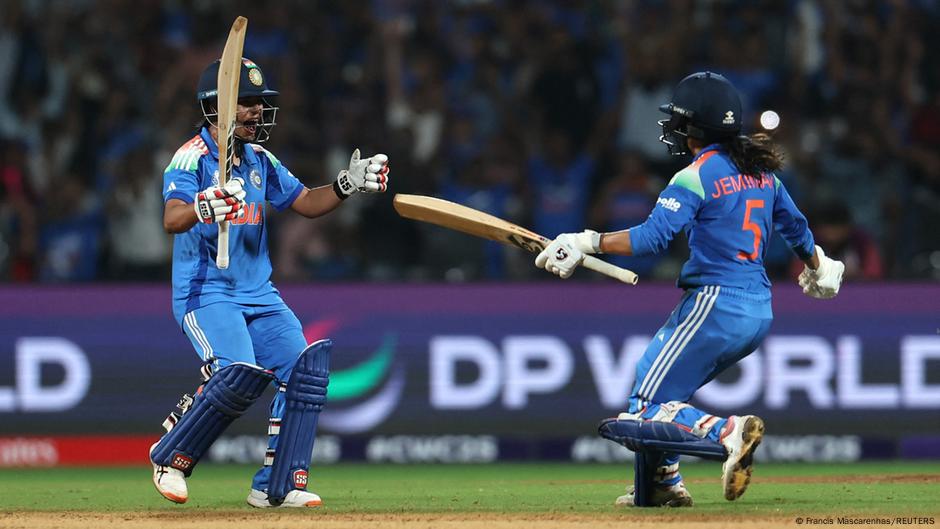On Sunday, India women won the Cricket World Cup for the first time, in what is likely to be a game-changing victory for women, cricket and other sports in the country.
There were 45,000 excited fans in Mumbai to watch India beat South Africa at the end of the eight-team five-week tournament. Congratulations also came from Prime Minister Narendra Modi and other public figures.
It was an unforgettable experience for those watching in the stadium or elsewhere. “What happened was unbelievable, just a miracle,” Mumbai fan Tanvi Agarwal told DW. “I watched with my friends at a restaurant, and it was great to see both men and women, boys and girls, cheering for the team.”
It all ended after midnight but no one cared. “It was late at night but it looks like everyone woke up on Monday with a smile on their face.”
Agarwal said that he became emotional when the trophy was lifted. “When I was a girl in school, I didn’t get a chance to play cricket,” she said. “I felt very proud and emotional after seeing this win. We have come a long way and there are no limits for these players.”
Echoes of the 1980s win
The country’s most famous cricketer, Sachin Tendulkar, is not alone in comparing the “historic triumph” – as described by the Indian Express – to the 1983 World Cup win. Four decades ago in London, the men’s team won the trophy for the first time, helping India on its way to becoming a major power in cricket.
“That 1983 win changed everything for men’s cricket and it will do the same for women’s,” Dr. Sarthak Mandal, president of the Indian Sports Management Association, an independent body that promotes sports development in the country, told DW.
“In India, we celebrate people who win because we have kind of a culture of, ‘If you don’t win, you don’t deserve’.”
After losing the finals in 2005 and 2017, it seemed like it was never going to happen for the women. “People were beginning to lose patience so it was time to win and the women gave birth.”
Mondal believes it will take time for everything to sink in for these heroes. “I watched the players being interviewed after the game and I don’t think they realize what they’ve done, maybe in 50 years they’ll realize.”
change is finally coming
This has not been an easy journey. At 21, Shafali Verma, the youngest member of the victorious team, was one of the heroes in the final, scoring 87 runs and taking two wickets. It has been just 12 years since he had to disguise himself as a boy to play cricket for his local team in Haryana, one of the most conservative states in India.
However, progress has been made since then. In 2022, the Cricket Board of India made equal pay mandatory for men and women when playing international matches. Higher pay means more security, more time to train, better fitness levels and more professionalism.
International Cricket Council chief Jay Shah paid tribute to the work done on X.
The Women’s Premier League, founded in 2023, 15 years after the men’s version, has become one of the most lucrative sports leagues in the world. This was a big step forward for women’s sports and players.
“Women get paid two per cent more than men in terms of revenue generated from the Premier League,” Mandal said. “They may produce less but get paid more in real terms.”
Although international match fees have been equalised, male players still earn significantly more through their much larger annual retainers and more lucrative commercial deals with the country’s cricket board.
Success can bring change at the grassroots level
Mondal hopes the World Cup victory will bring more money into the sport from both the public and private sectors, helping more young players follow in the footsteps of champions.
Cricket fan Tanvi Agarwal said, “When I was growing up, there weren’t very many famous female cricketers, but now there are all these women who are icons now.” “I’m sure young girls are watching all this. It would be impossible not to be inspired.”
This can only be good for all aspiring female athletes. “There should be more avenues for girls to get involved in sports in schools and schools should encourage more sports for girls,” Mandal said. “If there is investment, women have shown that they can achieve much more than men.”
If success takes women’s cricket to the next level, it is sure to have ramifications for other sports in the country.
“There is no doubt that what women cricketers have done will inspire other sports,” former All India Football Federation general secretary Shaji Prabhakaran told DW.
“We need to look at the structure, equality in pay and how players are incentivized to play,” Prabhakaran said. Cricket teams come from every corner of the country with a population of 1.4 billion. “In football, women players are not from all over India but from certain areas and that is a big difference.”
In tough times for men’s football in India, the women have stepped up and qualified for the Asian Cup for the first time in Australia in March. “It was a big achievement but it got the football community excited,” Prabhakaran said.
“If the women’s football team qualifies for the World Cup, it will excite neutrals and that is the long-term goal. This cricket win excites every Indian. It will never be forgotten.”
Edited by: Matt Pearson





Leave a Reply